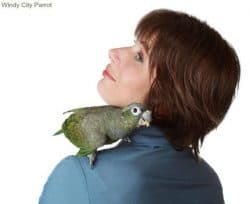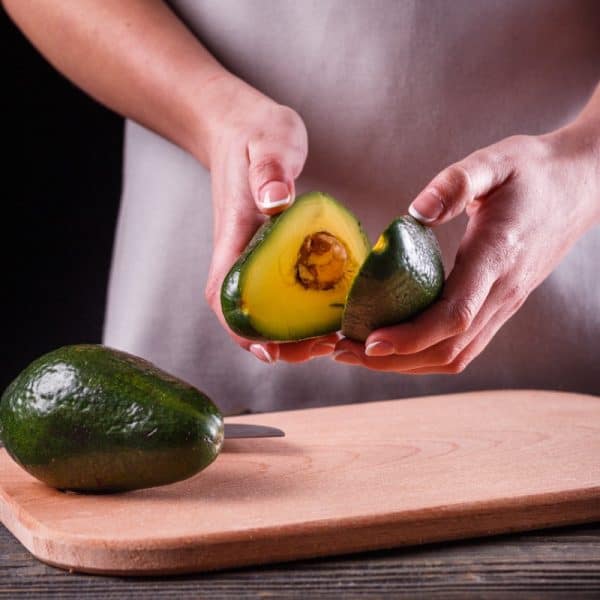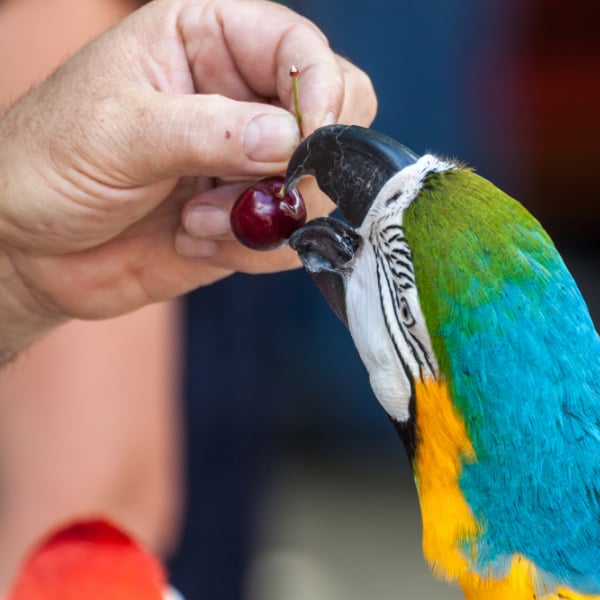Last Updated on by Mitch Rezman
How to Easily Introduce New Foods to Your Parrot
Some parrots are weaned to a diet that is basically all seed or all pellets.
While pellets are supposed to be nutritionally complete, I believe parrots miss a lot of nutrition and foraging activity if they don’t also eat fruits and vegetables that are on the bird-safe list.
Some parrots easily try whatever is offered, but they tend to be in the minority.
For the most part, parrots tend to reject new foods and new toys until they become familiar with them.
I have found a very easy method of breaking through the prejudice parrots have against new food and the method, in an adjusted form I’ll write about at the end of this article, it works for getting your parrot to try new toys, too.
Some people who have tried this method have experienced same-day results while others had to try several times to make progress.
Does this mean your parrot will like every food it tries?
No, just like people, parrots have preferences for certain foods and various ways of preparing those foods.
For example, my previous parrots were big fans of raw corn on the cob.
Mango will not touch a kernel of raw corn but he will eat cooked corn just fine.
He loves pasta in any form but if I save some in the refrigerator he wants warm water run over it, at the very least, and would probably prefer it to be heated on the stove.
Your parrot will choose the foods it prefers and the textures it likes, but variety is the spice of life for parrots just as for humans.
Mango’s (a Sun Conure) stand-in stunt bird
We know from basic parrot psychology used from observing our parrots that parrots LOVE drama. Every parrot is a drama junkie.
This is why if we shout at them for screaming, they will just scream back and train you to provide their drama.
Parrots thrive on getting their companion humans to respond with drama, to the point that they will knowingly behave very, very badly in an effort to get a dramatic response.
While we discourage providing drama in most situations, we can use this drama to increase their interest in the food you want them to try.
First, prepare a saucer or plate with one or two foods you want the parrot to learn to eat.
I generally suggest one fruit and one vegetable but that is by no means a rule; use whatever you have on hand that is healthy and fresh.
Cut up some pieces in appropriate sizes for you to eat and some inappropriate sizes for your bird.
If you have a small parrot like a parakeet, you need to chop tiny bites. If you have a cockatoo or macaw, it can handle larger pieces.
Adjust for any sized parrot in between by using common sense.
Depending on where your parrot’s cage is located, either sit down or stand next to it.
Be sure it is a time of day that your parrot is active and probably a little hungry.
I’ve found this works best if the parrot is just rising, has taken its morning poop and I have removed the food and water dishes in order to prepare their morning food.
You could wash the seed dish and let it dry while performing this exercise.
Just remember at the end of the session to replace the food and water dishes.
Here, I am suggesting that you remove food and water for a short while.
But never try to use lack of food or water as a means of discipline.
The bird will not understand and it will possibly lose some trust in you, the head of its flock.
It is cruel rather than effective for trying to stop bad behavior.
Another good time to introduce new foods is just after the parrot wakes up from a nap.
Parrots tend to eat, play, poop, nap, wake, poop and repeat when not spending out of the cage time with their human flock.
Talk to your parrot and make eye contact to be sure you have the parrot’s attention.
Talk excitedly to the bird and show it your plate of food.
Offer him a piece of one of the foods, the one you plan to get him to try first.
Of course, he will likely completely ignore it or take it in its beak and toss it down.
Keeping in mind that your parrot can’t resist drama, pick up a piece of the same food but in the size, you cut for yourself. Show your bird that it is the same food. Then eat a bite of the food.
Make ooh’ing and ahh’ing sounds, smile, and make a really HUGE deal about the food as if you’d never tasted anything so great ever before.
Lick your lips.
Talk in a slightly louder than normal, very excited tone and tell the bird about how wonderful the food tasted.
The more dramatic and enthusiastic you make the show, the better.
Repeat with another bite.
Now try offering a bird-sized bite to your parrot.
Your bird may step closer to look at the food, or it may even taste it.
It should at least show more interest than it has in the past when you have offered this same food in its food dish.
It might take it in its beak and drop it to the floor without biting into it.
Be sure you still have the interest of the parrot.
If it loses focus, it’s time to stop the session for that day or at least for that part of the day.
If you are sure you are going to attempt a second session later in the day, serve a very small amount of treats or foods your parrot already accepts so that it will be just a tiny bit hungry for things other than its seeds or pellets.
Continue showing very dramatic behavior while holding up your next bite of the same food and while eating it.
Show even more enthusiasm through your voice, body language and facial expression.
Then offer a bite of the food to your parrot again.
Its level of interest should be even higher.
If he doesn’t take a bite of the food this time, put it aside to place in its food dish at the end of the session.
Repeat this process no more than two or three times.
If you only prepared one food, put a few pieces in the food dish, feed it if this was a morning exercise and leave your bird for a while.
You may see it investigate after you walk away, especially if it is not fully tame or a bit shy.
If you prepared two foods, switch foods and perform the same process with the other food on your plate.
Remember to be just as enthusiastic and expressive as before. The more drama you create about the food, the more likely your parrot is to taste the food and find it likes it enough to eat it when it’s on the menu.
In the wild, parrots learn what is safe and good to eat from their flock members, especially their parents and the flock leader.
In our homes, the humans and other birds in the house act as a surrogate flock.
We can teach our birds what is good to eat by showing them using this special technique.
This exercise also adds to our bonding with our parrots because they instinctively want to eat with their flock members.
Since you are part of the flock, they want to eat when they see you eating, even if they aren’t really very hungry at the moment.
I’ve had replies from people I’ve shared this tip with that after getting the bird to try the first food and finding it great, the bird would accept anything.
Others were amazed that on the first or second day their parrot actually tried the new food. This system really works!
I was told by the former owners that Kiwi, my little rehomed budgie, would eat no fruits, veggies or people foods at all.
Using this method and his observations of Mango’s eating habits he is now loving quite a few healthy foods besides seeds.
Just yesterday, Mango the sun conure had grabbed a piece of Kiwi’s share of apple.
Kiwi walked right up and took it right out of Mango’s mouth! Kiwi must not have been exposed to any food choices in his former home or not exposed the right way.
Introducing New Toys the Easy Way
Here’s how I suggest you modify this method to work with introducing a new toy.
The differences are very simple.
Instead of creating a dramatic performance with food, do it with the new toy.
The reason parrots are reluctant to accept a new toy is because they want to be sure it is safe and isn’t going to suddenly turn them into lunch.
Many parrots will actually walk far around the cage to avoid getting too close to the new toy at first.
Show the parrot the toy.
Talk to the toy and the parrot while smiling and even hug the toy.
Stroke it as if you were petting it like you do your bird.
Even if your bird doesn’t allow scratches and scritches, it will still get the idea that you love the object and are not afraid of it.
Make happy sounds and continue to talk with great enthusiasm and emotion about the toy while allowing your parrot to watch you pay attention to it and the toy.
If your bird is tame, you can then allow the bird to join you and the toy and offer the parrot the chance to touch the toy.
Parrots have short attention spans, so only continue your performance about 5 minutes unless your parrot accepts the toy and plays with it along by choice.
If it does not touch the toy at all, put it away out of the bird’s sight and repeat the process the next day.
Bird toys bigger than a 5th grader!
Bird safe handmade in the USA – check em out
You may not have to repeat the process but if you do, it is very likely that the bird will accept the toy within 3 or at most 4 days.
If it does not show any interest whatsoever or shuns the toy completely for that long, examine the toy critically to see if there is something the bird may really not like about it, such as eyes that look too realistic, reminders or shapes too much like a predator or perhaps simply a color the parrot dislikes.
If the bird continually rejects the toy for several more days of working with it, put that toy on the back burner and realize that not every toy is going to appeal to every bird.
Try the process with a different toy and if it works with that toy, you’ll know there really is something about the first toy that puts the bird off.
“Hi mom – this toy sure is fun to play with”
Try it again in a few months and it might accept it but if it continues to reject the object, just put it away because it is likely the parrot will never enjoy that toy and it needs its cage space filled with toys that keep it active and interested rather than taking up space with items the bird hates.
You might sterilize the toys that are disliked and give them to your parrot parent or friend with a bird about the same size as yours because their bird may love a toy your bird hates.
You can also give sterilized toys to a local parrot rescue for their inhabitants.
So let’s eat healthily and play with fun toys as we teach our parrots to do try new foods and play with new toys.
written by nora caterino
approved by catherine tobsing





